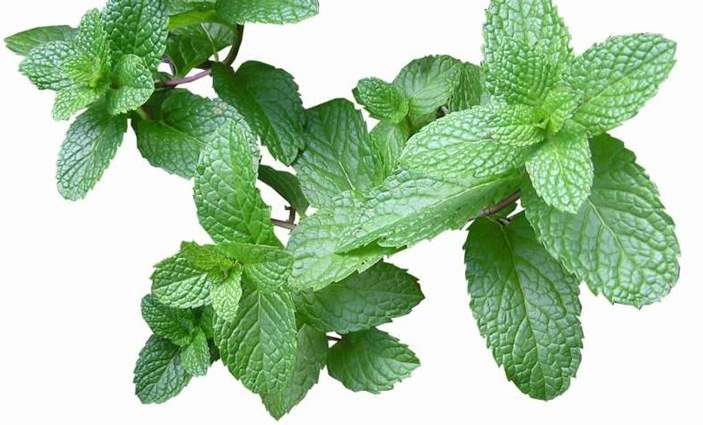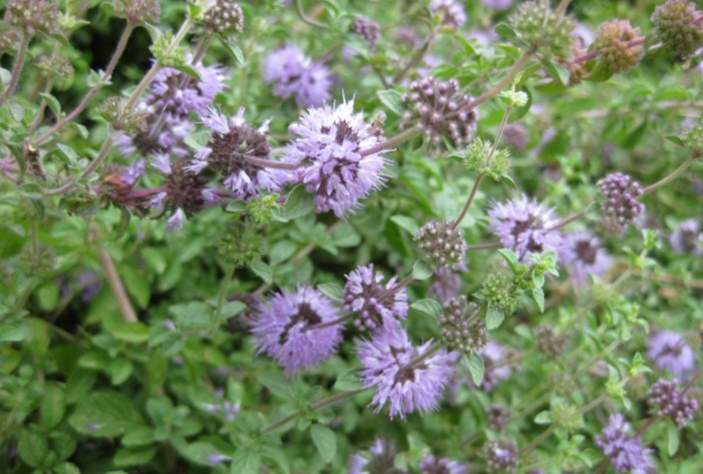Mentha (mint) is a genus name about 25 perennial aromatic herbs in the family Lamiaceae, which also has bee balm, catnip, hyssop, lavender, lemon balm, rosemary, savory, thyme among others. They are native to Eurasia, Australia, North America, and Southern African, where they grow in varied conditions.
Its leaves that have a fresh warm, aromatic, sweet flavor that features a cool aftertaste serve as a culinary herb in many cuisines as well as in teas (like Touareg tea), syrups, jellies, ice creams, candies, liquors, and beverages.
Mint essential oil and menthol (that makes 40-90% of the essential oil) have extensive application in breath fresheners, toothpaste, chewing gum, candies (chocolate), antiseptic mount rinses and in aromatherapy. Also, it serves as a natural pesticide to kill ants, cockroaches, wasps, and hornet while menthol is ingredient perfumes and cosmetics.

Can rabbits eat mint?
Yes. Rabbits can eat mint leaves, stems, or flowers from all Mentha species, including spearmint, apple, chocolate mint, and other, except for the Mentha pulegium species, commonly known as pennyroyal, European pennyroyal, mosquito plant, squaw, pennyrile, or pudding grass.
Pennyroyal works as a pest repellent and insecticide. It has 80% to 92% cyclohexanone pulegone. This high concentration of Pulegone is what makes it potentially toxic to rabbits, other animals, or even human beings. It will cause various ailments, especially if ingested in large amounts. In humans, pennyroyal may also induce abortions or menses.
Except for the pennyroyal, Mentha roots are not toxic either. However, they have little or no nutritional value, a reason why not to give them to your bunnies.
Owing to their strong smell and taste, some rabbits may not like mint. It is one of the plants bunny’s distastes together with others like rosemary, thyme, bee balm, chives, sage, yarrow, catmint, among others.
While in the wild, rabbits don’t eat mints or strongly scented herbs. They tend to avoid them unless they don’t have a choice. In such a case, they may nibble them a bit.
Is mint good for rabbits?
Yes. Apart from pennyroyals, which is toxic, the rest of the genus Mentha species are ok for your rabbits. They contain vitamins A, C, folate, riboflavin, iron, potassium, magnesium, calcium, (200mg/100g), manganese, and dietary fiber.
Also, mint has antioxidants that will help neutralize free radicals and boost immunity and also has anti-inflammatory properties (has rosmarinic acid) that will help minimize any inflammation, including one caused by inflammatory bowel diseases.
The other reason why you should consider giving your bunnies a little mint leaves is its calming or soothing effects as well as masking bath breathe. This calming herb may help soothe stomach upsets (relaxes stomach muscles) aid resolve indigestion, colic, or gas.
Still, on benefits, Rise and Shine Rabbitry notes mint may help “firms loose stools, decreases the milk flow of does during weaning, and is a good herb for treating mastitis. It is safe as food for dry does, and bucks DO NOT FEED to lactating does.”
Furthermore, Rise and Shine Rabbitry notes that it may help in stimulating the liver, dealing with colds and eye infections. However, you are advised not to use it for long as it may cause mucous membrane irritation, and it is not suitable for baby rabbits.
In humans, this herb may help better brain function, reduce breastfeeding pain, help reduce stomach pain in kids, make one feel better after surgery, and menthol works as a decongestant. There are no specific studies to show if rabbits can have these benefits from this herb.
Giving mint to your bunnies
When it comes to herbs, feed them as healthy snacks, treats, or garnishes and not a replacement to usual diets. Therefore, give them only a small amount (in moderation) a few times a week. We don’t see the reason for your bunny having mint every day. Also, ensure leafy veggies and grasses should form the bulk of their fresh foods.
Avoid excessive amounts as it may cause stomach problems, diarrhea, or gas. Also, it is high in calcium and an excessive amount together with other high calcium veggies like kale, Brussels sprouts, collards, mustard greens, Swiss chard, and so on may not be a good idea.
While fresh or dried leaves, flowers, and stems are ok for your bunnies, we would recommend fresh leaves, harvested before it begins to flower. Also, they can have mint tea if it doesn’t have any other additive.
When buying this herb for your bunnies, go for organic source or sources not treated with harmful pesticides or herbicides, and wash it under running water.
My rabbit ate pennyroyals
If your bunny eats pennyroyals, since they are toxic, check for toxicity such as stomach and intestinal upset or inflammation, diarrhea, reduced appetite, lethargy, seizures, weakness, depression, low or high body temperature, depression among others.

More on Mentha
The popular Mentha species include water (marsh), corn (Japanese peppermint or wild, field or banana mint), Australian, Canadian (American wild), horse, slender, forest mint. Others are spearmint (which has garden mint as one of its cultivars), Dahurian thyme, Hart’s pennyroyal, native pennyroyal, pennyroyal, and apple mint (together with its variegated cultivar, the pineapple mint).
There are also many hybrids, including ginger (Scotch spearmint), peppermint, chocolate, false apple, large apple (foxtail, hairy, wooly, Cuban, mojito, or Yerba Buena) as well as sharp-toothed and red raripila mint.
Finally, while they may bear the name, the Vietnamese mint (Persicaria odorata) and Mexican mint marigold (Tagetes lucida) are not members of genus Mentha.
Conclusion
When feeding your bunny, remember to give them unlimited hay such as timothy, 10-15% fresh foods, 5% high fiber pellets, and all rabbit treats can account for up to 5% of their daily food intake. Treats will include both the commercial and those you find in homes, including herbs, flowers, fruits, and non-leafy veggies.
